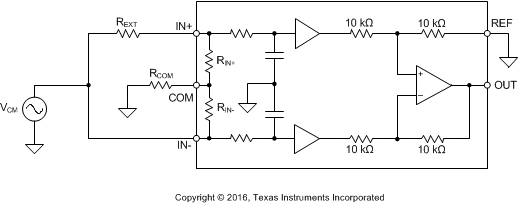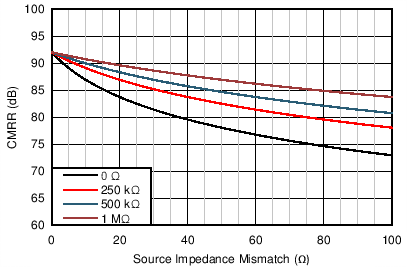ZHCSGP4C August 2017 – May 2019 INA1650-Q1 , INA1651-Q1
PRODUCTION DATA.
8.1.2 Common-Mode Input Impedance
The high CMRR of many line receivers can degrade by impedance mismatches in the system. Figure 44 shows a common-mode noise source (VCM) connected to both inputs of a single channel of the INA165x-Q1. An external parasitic resistance (REXT) represents the mismatch in impedances between the common-mode noise source and the inputs of the INA165x-Q1. This mismatched impedance may be due to PCB layout, connectors, cabling, passive component tolerances, or the circuit topology. The presence of REXT in series with the IN+ input degrades the overall CMRR of the system because the voltage at IN+ is no longer equal to the voltage at IN–. Therefore, a portion of the common-mode noise converts to a differential signal and passes to the output.
 Figure 44. A Single Channel of the INA165x-Q1 Shown With Source Impedance Mismatch (REXT) and Optional Resistor (RCOM)
Figure 44. A Single Channel of the INA165x-Q1 Shown With Source Impedance Mismatch (REXT) and Optional Resistor (RCOM) While the INA165x-Q1 is significantly more resistant to these effects than typical line receivers, connecting a resistor (RCOM) from the COM pin to the system ground further improves CMRR performance. Figure 45 shows the CMRR of the INA165x-Q1 (typical CMRR of 92 dB) for increasing source impedance mismatches. If the COM pin is connected directly to ground (RCOM equal to 0 Ω), a 20-Ω source impedance mismatch degrades the CMRR from 92 dB to 83.7 dB. However, if RCOM has a value of 1 MΩ, the CMRR only degrades to 89.6 dB, which is an improvement of approximately 6 dB.
 Figure 45. CMRR vs Source Impedance Mismatch for Different RCOM Values
Figure 45. CMRR vs Source Impedance Mismatch for Different RCOM Values RCOM does not need to be a high-precision resistor with a very tight tolerance. Low-cost 5% or 1% resistors can be used with no degradation in overall performance. The addition of RCOM does not increase the noise of the audio signal path.
In single-supply systems where AC coupling is used at the inputs of the INA165x-Q1, adding RCOM lengthens the start-up time of the circuit. The input AC-coupling capacitors are charged to the midsupply voltage through the RCOM resistor, which may take a substantial amount of time if RCOM has a large value (such as 1 MΩ). Do not use RCOM in these systems if start-up time is a concern. In dual-supply systems with input AC-coupling capacitors, the capacitor voltage does not need to be charged to a midsupply point, because the capacitor voltage settles to ground by default. Therefore, RCOM does not increase start-up time in dual-supply systems.